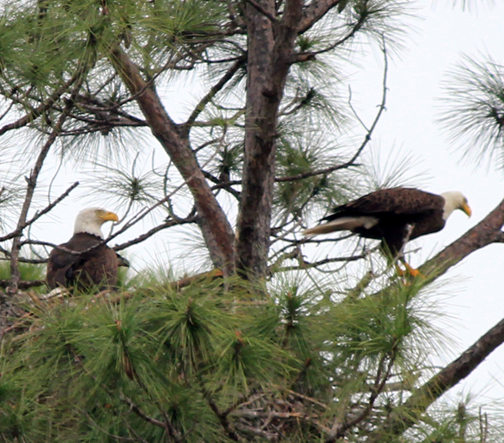
Florida’s eagle population now exceeds 4,000 birds each year
By Stan Kirkland, FWC
I get to do many special and enjoyable things in my job with the Florida Fish and Wildlife Conservation Commission (FWC). One of those things is checking on an eagle’s nest on North Bay in Bay County, on private land, and unlike many nest sites where trees obscure the nest, that wasn’t the case with this nest. The nest is near the crown of a tall longleaf pine and highly visible.
A bald eagle nest, by the way, is unlike any other bird nest in this part of the country. Typical of eagle nests, the nest is probably five to six feet across, and must weigh 500 pounds or more.
In addition to the adults, there are two young, immature eagles in the nest. The young bird that we could see the best continually moved around and flexed his wings.

The bald eagle nesting season in Florida is defined as Oct. 1 through May 15. Based on the size of the pair of juvenile birds, I suspect these birds will take flight in the next six to eight weeks.
What is really remarkable is the recovery of the bald eagle population in Florida and the lower 48 states over the last four decades. Due to the unintended consequences of using the pesticide DDT from the 1940s through the early ‘70s, bald eagle numbers dropped precipitously. DDT caused eggshell thinning and the loss of reproduction.
The widespread use of DDT was banned in 1972 and following passage of the Endangered Species Act in 1973, Florida and other states began breeding season surveys to monitor the species “anticipated” recovery.
When Florida’s bald eagle population was first surveyed during the 1972-73 season, there were fewer than 200 nesting territories in only 20 counties. The 2010-11 surveys showed the nesting territories increased to 1,362 in 65 counties. Biologists say that Florida’s eagle population, which includes adults and offspring that will soon leave the nest, now exceeds 4,000 birds each year. Some of Florida’s population will migrate north this spring, going as far north as Nova Scotia, before returning next fall.
Florida’s number of nesting territories is third only to those of Alaska and Minnesota.
The bald eagle was removed from the endangered species list in 2007, but the species remains protected under both state and federal law.

